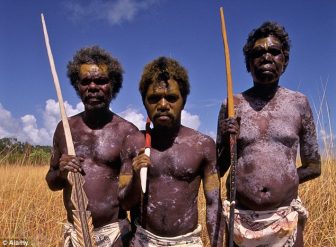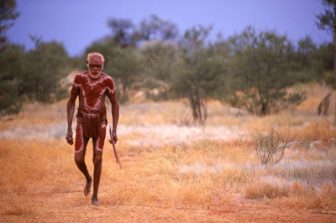 The word aborigine means “from the beginning.” In Australia, this word began to be used to refer specifically to the continent’s nearly one million indigenous inhabitants at the time of the British invasion in 1788. Many cultures have been lost since then, due to violent conflict between Aborigines and successive waves of new settlers. Some cultures have survived and renewed their focus on kin networks, close religious and legal relationships to the land, and revitalization of their culture and language. Of 250 languages, 20 remain.
The word aborigine means “from the beginning.” In Australia, this word began to be used to refer specifically to the continent’s nearly one million indigenous inhabitants at the time of the British invasion in 1788. Many cultures have been lost since then, due to violent conflict between Aborigines and successive waves of new settlers. Some cultures have survived and renewed their focus on kin networks, close religious and legal relationships to the land, and revitalization of their culture and language. Of 250 languages, 20 remain.
Experts believe ancestral Aborigines arrived approximately 46,000 years ago, possibly when sea levels were low during the Ice Age. Archaeological sites near Melbourne and Perth are dated to 40,000 years ago, shell middens to 30,000 years ago. Indigenous peoples of Australia and New Guinea, closely related, probably share a common origin in Indonesia. Aboriginal language diversified into a large number of families with no clear relationships, suggesting a much longer period of differentiation than the single Austronesian language family had in the South Pacific.
Early tools consisted of flakes and pieces of stone with sharp edges. Ground-edged hatchet heads found in the North were the only prehistoric tools shaped into regular patterns. From 3000 BC, stone tools spread throughout the continent and may have been used as currency as well as for woodworking.
 The clan, the most important social group, moved within a specific tract of land in response to seasonal variation or the need to be at a specific place for ritual purposes. Clans were linked as part of exchange networks that moved objects or ideas over long distances. They also maintained and transmitted culture with images and songs describing creation, short songs containing powerful information related to specific localities, and series of songs strung together in song lines. Rock and body painting and decoration of portable objects linked clans to the land, each other, and the past.
The clan, the most important social group, moved within a specific tract of land in response to seasonal variation or the need to be at a specific place for ritual purposes. Clans were linked as part of exchange networks that moved objects or ideas over long distances. They also maintained and transmitted culture with images and songs describing creation, short songs containing powerful information related to specific localities, and series of songs strung together in song lines. Rock and body painting and decoration of portable objects linked clans to the land, each other, and the past.
Aboriginal people believed in the continuing existence of spirit-being ancestors who lived on earth during “the Dreaming” and created the natural world before the arrival of humans. They took various forms represented by totems and behaved as people. They aged and had to return to the sleep from which they awoke at the dawn of time, but they continued to influence natural events and breathe life into newborns. Their wisdom regarding kinship, hunting, and marriage relationships was highly desired.
 Australian Aborigines were hunter-gatherers identified by a managerial forager prehistoric lifestyle that included vegetation burning, replanting, and occasional wetland ditching, depending on available natural resources. In western Victoria, elaborate systems were constructed for trapping eels. In northern wetlands, tubers were replanted to promote future growth. Elsewhere, wells were sunk to raise large crops of yams; trees were transplanted; streams were diverted for irrigation; and digging was undertaken to encourage roots. Fire was widely used to open pathways, kill vermin, remove dry vegetation and promote new growth, cook edible animals in their burrows and nests, and prevent more destructive natural fires. Yet when Europeans saw these methods of managing grasslands and diversifying plant and animal life, they did not recognize Aborigines as farmers, gardeners, or herders. Absence of defined fields, permanent villages, and edible domestic animals led them to regard Aboriginal country as unproductive and unclaimed. Aborigines seemed to be wanderers, an inferior people who were not using the land and who should be forcibly removed to make way for colonization. Australia was annexed to the British Empire on the basis that it was terra nullius, or uninhabited wasteland. This myth prevailed until 1992, when a High Court judged in the Mabo case that native title to land still existed in Australia.
Australian Aborigines were hunter-gatherers identified by a managerial forager prehistoric lifestyle that included vegetation burning, replanting, and occasional wetland ditching, depending on available natural resources. In western Victoria, elaborate systems were constructed for trapping eels. In northern wetlands, tubers were replanted to promote future growth. Elsewhere, wells were sunk to raise large crops of yams; trees were transplanted; streams were diverted for irrigation; and digging was undertaken to encourage roots. Fire was widely used to open pathways, kill vermin, remove dry vegetation and promote new growth, cook edible animals in their burrows and nests, and prevent more destructive natural fires. Yet when Europeans saw these methods of managing grasslands and diversifying plant and animal life, they did not recognize Aborigines as farmers, gardeners, or herders. Absence of defined fields, permanent villages, and edible domestic animals led them to regard Aboriginal country as unproductive and unclaimed. Aborigines seemed to be wanderers, an inferior people who were not using the land and who should be forcibly removed to make way for colonization. Australia was annexed to the British Empire on the basis that it was terra nullius, or uninhabited wasteland. This myth prevailed until 1992, when a High Court judged in the Mabo case that native title to land still existed in Australia.
References:
- Elkin, A. P. (1954). The Australian Aborigines: How to understand them. Sydney, Australia: Angus & Robertson.
- \Swain, T. (1993). A place for strangers: Towards a history of Australian Aboriginal being. Cambridge; New York: Cambridge University Press.
- Tindale, N. B. (1974). Aboriginal tribes of Australia: Their terrain, environmental controls, distribution, limits, and proper names. Berkeley: University of California Press.

